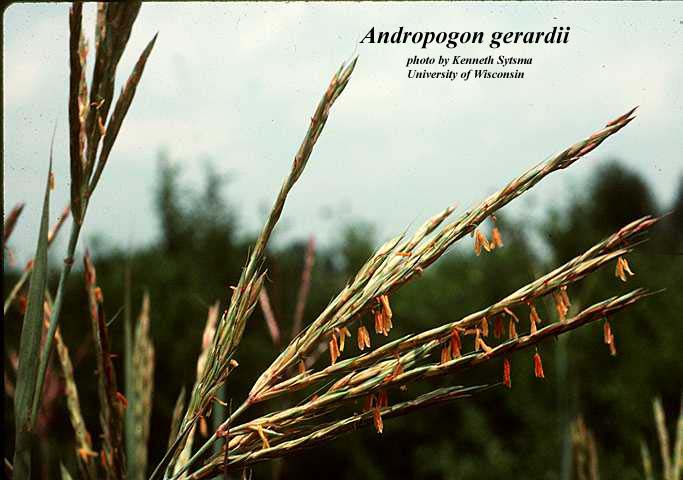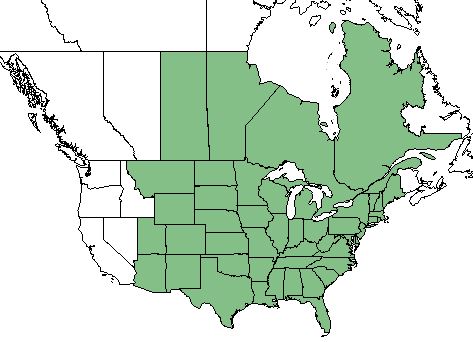Difference between revisions of "Andropogon gerardii"
(→Taxonomic Notes) |
|||
| Line 19: | Line 19: | ||
}} | }} | ||
==Taxonomic Notes== | ==Taxonomic Notes== | ||
| − | Synonyms: ''Andropogon gerardi'' Vitman | + | Synonyms: ''Andropogon gerardi'' Vitman; ''Andropogon provincialis'' Lamark; ''Andropogon furcatus'' Muhlenberd ex Willdenow |
Varieties: none | Varieties: none | ||
Revision as of 19:38, 5 March 2019
Common names: Big Bluestem; Turkeyfoot
| Andropogon gerardii | |
|---|---|

| |
| Photo by the Atlas of Florida Plants Database | |
| Scientific classification | |
| Kingdom: | Plantae |
| Division: | Tracheobionta |
| Class: | Liliopsida - Moncots |
| Order: | Poales |
| Family: | Poaceae |
| Genus: | Andropogon |
| Species: | A. gerardii |
| Binomial name | |
| Andropogon gerardii Vitman | |

| |
| Natural range of Andropogon gerardii from USDA NRCS Plants Database. | |
Contents
Taxonomic Notes
Synonyms: Andropogon gerardi Vitman; Andropogon provincialis Lamark; Andropogon furcatus Muhlenberd ex Willdenow
Varieties: none
Description
Also known as big bluestem or turkeyfoot, A. gerardii is a native perennial graminoid that is a member of the Poaceae family. It is tufted, and contains short, scaly rhizomes. It is known for being a tall graminoid, ranging from 6 to 8 feet tall, and is very leafy at the basal region with some leaves that are carried up on the stem. As well, big bluestem contains rhizomes that are usually 1 to 2 inches below the soil surface for clonal reproduction [1].
Distribution
A. gerardii is distributed across the United States and Canada, but not past New Mexico or Montana [1].
Ecology
Habitat
Big bluestem can be found in prairies, open woods, along riverbanks, meadows, and even roadsides. It is particularly abundant in lowland prairies and sandy areas [1]. It develops best in mesic communities. [2] It is usually the dominant species within the ground community. [3] The soils within these habitats can range from sandy or loamy to clay or mesic bogs. [4]
Associated species - Panicum virgatum, Schizachyrium scoparium, and Sorghastrum nutans [5]
Phenology
A. gerardii has been observed to flower from August until October [6].
Seed bank and germination
Seeds will usually germinate within 4 weeks when regularly irrigated [1].
Fire ecology
The rhizomes of A. gerardii are known to resprout after a fire disturbance, and regeneration following fires is much quicker in the springtime than the summertime since the rhizomes contain winter-stores with carbohydrates [1]. As well, flowering of A. gerardii has been seen to significantly increase in late-summer fires rather than early-spring fires. [2]
Use by animals
A. gerardii is utilized by birds and mammals for nesting and escape cover during the summer and winter, and contributes to the spring nesting habitats since it resists lodging under snow cover [1]. It is also one of the most important forage species for animals in the tallgrass prairie regions. [7]
Conservation and Management
For management, A. gerardii has a considerably weak seedling compared to its competition, so control of its competition is necessary, such as high mowing for weed control or even grazing of competing cool season grasses before the big bluestem is 1 inch tall in the spring [1].
Cultivation and restoration
There are several cultivars available of A. gerardii, including 'Bison' (ND), 'Bonilla' (SD), 'Champ' (NE, IA), 'Kaw' (KS), 'Earl' (TX), 'Niagara' (NY), 'Pawnee' (NE), and 'Rountree' (IA) [1].
Photo Gallery
References and notes
- ↑ 1.0 1.1 1.2 1.3 1.4 1.5 1.6 1.7 USDA Plants Database URL: https://plants.usda.gov/core/profile?symbol=ANGE
- ↑ 2.0 2.1 Copeland, T. E., et al. (2002). "Fire season and dominance in an Illinois tallgrass prairie restoration." Restoration Ecology 10(2): 315-323.
- ↑ Howe, H. F. (1995). "Succession and Fire Season In Experimental Prairie Plantings." Ecology 76(6): 1917-1925.
- ↑ Florida State University Robert K. Godfrey Herbarium database. URL: http://herbarium.bio.fsu.edu. Last accessed: June 2018. Collectors: Robert A. Norris, John B. Nelson, Robert K. Godfrey, R. Kral, A. F. Clewell, Gary R. Knight, Loran C. Anderson, Jean W. Wooten, S. Mitchell, Ann F. Johnson, Wilson Baker, R. Komarek, J. M. Kane, Annie Schmidt, Floyd Griffith, Cecil R. Slaughter, R. C. Kennedy, and B. Tadych. States and counties: Florida: Gulf, Liberty, Wakulla, Jefferson, Leon, Jackson, Franklin, Gadsden, Calhoun, Santa Rosa, Washington, and Nassau. Georgia: Thomas, and Grady. Missouri: Callaway.
- ↑ Abrams, M. (1988). "Effects of Burning Regime on Buried Seed Banks and Canopy Coverage in a Kansas Tallgrass Prairie." The Southwestern Naturalists 33(1): 65-70.
- ↑ Nelson, G. PanFlora: Plant data for the eastern United States with emphasis on the Southeastern Coastal Plains, Florida, and the Florida Panhandle. www.gilnelson.com/PanFlora/ Accessed: 1 JUN 2018
- ↑ Gould, F. W. (1967). "The Grass Genus Andropogon in the United States." Brittonia 19(1): 70-76.